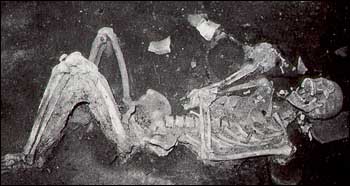

 The
Evolution of Intelligence
The
Evolution of IntelligenceRenato M.E. Sabbatini,
PhD
Go
to first page
Intelligence brought to humans many gifts and consequences. One of them, self-awareness, allow us to interpret reality in a subjective way and to conceptualize our existence in comparison with other animals and other human beings. Self-realization also allowed pre-historic humans to develop strategies and to antecipate the future. Another one is the ability to produce symbols and abstractions, i.e., internal mental representations of reality, "thought inventions" and beliefs not grounded on reality. Language gave us the ability to communicate using an open system of sound symbols (words), therefore enabling us to pass these realizations, beliefs, inventions, understandings and knowledge to other humans, from generation to generation.
All this produced three of the most distinctive characteristics of humankind: religion, art and culture.
Religion
 Let's
take religion. Self-realization led very early to the comprehension that
all human beings eventually die, a feat that no other animal is capable
of. The realization of mortality, then, separates humans from the rest
of the animal kingdom. This, as we will see, led eventually to burial rituals,
religion and faith, to the belief in the after-life, spirits, gods and
other abstract and non-observable entities related to Nature.
Let's
take religion. Self-realization led very early to the comprehension that
all human beings eventually die, a feat that no other animal is capable
of. The realization of mortality, then, separates humans from the rest
of the animal kingdom. This, as we will see, led eventually to burial rituals,
religion and faith, to the belief in the after-life, spirits, gods and
other abstract and non-observable entities related to Nature.
Experts agree that burying dead people is the first sign we can observe in the historical record of something akin to religion in humankind. Burials from the Upper Paleolithic (40,000 to 10,000 years ago) reflect the emergence of human's spiritual side, because these early H. sapiens sapiens put offerings and daily life objects, such as body ornaments, eating utensils, beverages, food, etc. in the deceased's grave. This marked a belief in an afterlife. as all religions do. No earlier hominid or ancient Homo sapiens ever buried their dead

A
ritually buried skeleton of an American Indian, with offerings by the side
Evidence from archeological Neanderthal sites such as as Shanidar in Iraq and Le Ferrassie in France, have given evidence that Homo sapiens neanderthalensis apparently buried their dead. However, Neanderthals did not bury offerings with the deceased, so, probably they were devoid of ritual and other similar symbolic activity.
Why did religion evolve? The best guess is that it is man's response to the uncontrollable forces of Nature. Author Gregory J. Rosmaita expresses this clearly:
"The burial rituals of prehistoric peoples bears mute testimony to the universal human urge to maintain the illusion of control over uncontrollable natural forces. While an illusion of control can be cast over the often daunting physical wilderness which stretches between birth and death, neither the psyche nor the intellect can confront death with complete confidence. Only through faith can mankind confront the ultimate mystery of existence without despair. [...] Caught between birth and death, man has developed sophisticated funeral rites not only for the benefit of the dead, but as a means with which he can ward off the ever present specter of death"Art and Culture
Another gift of intelligence, the ability
to observe Nature around us, and trying to understand it, led to art, such
as drawing pictures on caves's roofs and walls, or sculpting figurines.
These forms of expression first appeared 35,000 to 40,000 years ago in
Europe, during the Ice Age, and marked the beginning of what was a veritable
"creative explosion". Examples of this art are found in caves such as Lascaux,
in France, Altamira, in Spain, and in many other places in Europe.
30,000 years ago |

("Venus of Willendorf") |
We do not know for sure why H. sapiens discovered art and what was its purpose. Perhaps caves served as some sort of sanctuary, and the painting of animals was related to rituals aiming at increasing hunting chances. Or, perhaps, it was only because prehistoric men were bored by their extended stays in caves during the long winters of Ice Age. The noted expert Ian Tattersall believes that art was made possible by economic surpluses (caves, well replenished with smoked meat obtained by mass hunting, allowed humans to have ample time left for entertainment). Art could also be an attempt of these early modern humans to depict and to explain the world around them and how they related to that world.
Language brought culture, the preservation of customs, behaviors, attitudes and knowledge from generation to generation. Religion is closely related to myths, and history-telling, which are also present in all human cultures we have been able to study. These can happen only with the help of language, which instituted oral tradition. In fact, in all cultures which are devoid of written language, history-tellers are very important members of the community. Many of them commit to memory entire "books" of stories, which are repeated by heart and passed along from generation to generation using a kind of learning by rote of selected youths.
|
Renato M.E. Sabbatini, PhD Brain & Mind Magazine, February/April 2001 |
Copyright (c) 2001 Renato
M.E. Sabbatini
State University of Campinas,
Brazil
First published on: February
15th, 2001
URL of this page: http://www.epub.org.br/cm/n12/mente/evolution07_i.html